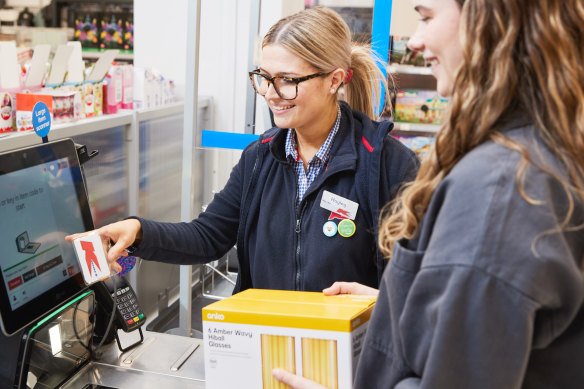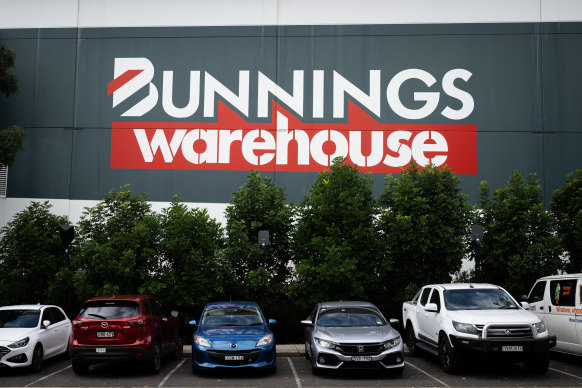This was published 7 months ago
Australia’s love for Kmart’s Anko drives profits higher for $85b giant
By Jessica Yun
Australian shoppers’ love for Kmart’s in-house brand Anko has defied a stagnant trading environment for many retailers and driven profit growth for parent company Wesfarmers as shoppers spent more at the department store amid lingering cost of living pressures.
As consumers increasingly turn to private label products to save money, Kmart notched a 4.4 per cent increase in revenue to $11.1 billion and a 24.6 per cent uplift in earnings to $958 million, meaning that while it sold slightly more volume, it was significantly more profitable.

Kmart has shone again for Wesfarmers.
Wesfarmers chief executive Rob Scott said Kmart’s “standout” result was many years in the works following improvements in product sourcing, design and digitising processes to keep costs down.
“What is driving sales is quite simple: it is fantastic products at amazing prices. That is what is making the big difference,” Scott told reporters on Thursday morning.
“Kmart as a business, through the Anko [range], is as much a product development and design company as it is a retail company,” he said, adding that new products in youth fashion, beauty, health and homewares were well received by customers who previously might not have shopped at the discount chain.
Kmart, which owns much of the supply chain behind Anko, can retain more margin than it otherwise would from purchasing goods from more expensive big-name brands. The in-house brand has cultivated a strong and loyal customer following and is known for providing low-cost alternatives to trendy items, driving Australian consumer frenzy around “dupe” culture.
“We develop and design products that are meeting those new trends,” Scott said.
Kmart’s strong results contrasted with its smaller sibling chain Target, which saw sales decline 4.5 per cent, and its underperforming Woolworths-owned rival Big W, where sales slid 3.9 per cent and earnings dove 90.3 per cent as it was forced to discount more.
Scott said on Thursday that Target will differentiate itself from Kmart by focusing on higher quality designs and styles in its clothing and homewares ranges.
Bunnings, Officeworks outshone
Wesfarmers’ stable of retail brands includes Bunnings and Officeworks, which also grew modestly in challenging trading conditions. The Wesfarmers group notched a 1.5 per cent uptick in revenue to $44.2 billion and a 3.7 per cent rise in net profits to $2.6 billion.
Bunnings’ revenue rose 2.3 per cent to nearly $19 billion, but earnings lifted by just 0.9 per cent to $2.25 billion. The hardware chain has been impacted by a crunch in residential construction due to high building costs over the past two years. Bunnings makes up nearly 43 per cent of revenue for the Wesfarmers group.
Officeworks’ revenue increased 2.3 per cent to $3.4 billion, with earnings lifting 4 per cent to $208 million.
“Different businesses will grow earnings at different rates at different times,” said Scott, adding that he was “very happy” with Bunnings’ profitability and pointing out the hardware chain grew significantly more during COVID than Kmart did at the time.
“We still see that there’s good potential for growth in Bunnings, Officeworks and Kmart.”
Interest rate cuts would go some way in boosting construction and building activity, but Scott said there was still a range of costs including energy, transport and insurance that was keeping inflation high.

Bunnings’ revenue rose 2.3 per cent to nearly $19 billion, but earnings lifted by just 0.9 per cent to $2.25 billion.Credit: Louie Douvis
The retail giant’s chief executive also said the federal government’s industrial relation reforms, which have been criticised across the business community, added extra layers of compliance and cost to the business, with “onerous fines” for breaches.
“We used to have a situation where the focus was on enterprise bargaining agreements at an enterprise level, and that was an opportunity to create a win-win arrangement for employees and businesses, and it enabled you to really drive productivity at an enterprise level.
Although enterprise agreements remain in place, we’re seeing more focus on industry-wide activity which doesn’t drive the same level of productivity and benefit for businesses or employees,” said Scott.
Meanwhile, the Catch.com.au online marketplace remains a loss-maker for the business, with a 35.9 per cent dip in revenue to $227 million. Earnings were $96 million, an improvement of 41.1 per cent.
Wesfarmers also has a number of industrial and chemical businesses in its portfolio. WesCEF’s earnings fell 34.2 per cent to $440 million; earnings from its Industrial and Safety business rose 4 per cent to $208 million; and Wesfarmers Health earnings rose 11.1 per cent to $50 million.
The company has announced a full-year fully franked dividend of 198¢ per share, a 3.7 per cent uptick on the year before.
The $85.4 billion ASX-listed conglomerate’s shares were 3.9 per cent lower in late afternoon trading.
The Business Briefing newsletter delivers major stories, exclusive coverage and expert opinion. Sign up to get it every weekday morning.